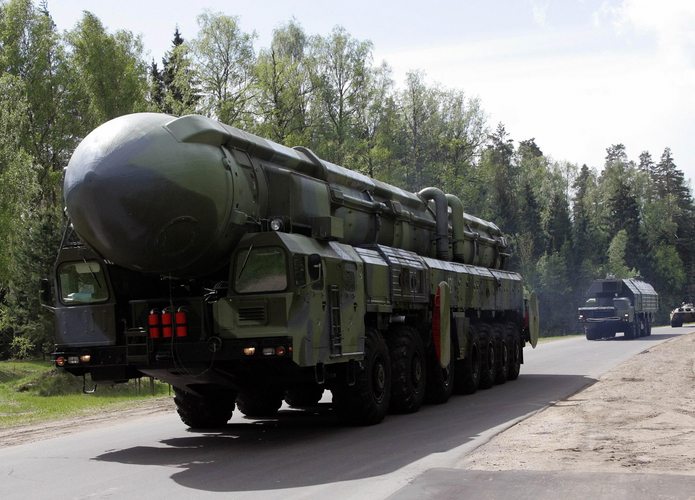Russia revealed on Monday that its armed forces had moved nuclear-capable Iskander missiles closer to Europe’s borders in response to the US-led deployment of a disputed air defence shield.
The advanced version of the Russian missile has a range of 500 kilometres (310 miles) and could potentially be used to take out ground-based radar and interceptors of the new NATO shield.
The announcement prompted fears in the US and neighbouring states such as Poland.
“We’ve urged Russia to take no steps to destabilize the region,” State Department deputy spokeswoman Marie Harf said in response, adding the US had also passed on to Moscow its neighbours’ concerns.
Those concerns were voiced earlier on Monday.
Poland’s foreign ministry called the planned missile movement “disturbing”.
“This is a matter for NATO and we can expect possible consultations and action (…) at the NATO and EU level,” added the ministry in a statement.
Estonia, Lithuania and Latvia called the news “alarming”.
Latvia’s Defence Minister Artis Pabriks, quoted by the Baltic News Service (BNS), said: “It is clear that it is alarming news as it is one of the arguments changing balance of powers in our region.”
He added “several Baltic cities” were threatened by the move.
Germany’s Bild newspaper first reported over the weekend that Russia had deployed about 10 Iskander systems in its Kaliningrad exclave — wedged between Poland and Lithuania — at some point in the past year.
A top Russian defence official said in response to the report that several Iskander batteries had been stationed in Russia’s Western Military District — a region that includes the exclave and also borders the European Union’s three Baltic nations that were once a part of the USSR.
“Iskander operational-tactical missile systems have indeed been commissioned by the Western Military District’s missile and artillery forces,” Russian news agencies quoted defence ministry spokesman Igor Konashenkov as saying.
He added that Russia’s deployment “does not violate any international treaties or agreements” and should therefore not be subject to protests from the West.
The Kremlin warned in 2011 that it could station the short- and medium-range ballistic missiles along the European Union’s eastern frontier in response to NATO’s missile defence programme.
Both the United States and the Western military alliance have argued that the shield is not aimed at Russia but is designed to protect the West from potential threats from so-called “rogue states”.
But Moscow fears the system — whose components include missile-positioning satellites — may one day be turned into an offensive weapon that targets Russian soil.
The Kremlin also believes the shield could in the future be expanded to a point that makes Russia’s own vast nuclear arsenal ineffective.
‘Highly political’ decision
A report prepared by the US-based Stratfor global intelligence consultancy and published by the WikiLeaks website said most Iskander missiles had previously been stationed in Siberia and the volatile North Caucasus region.
Stratfor added that the long-mooted but never-before implemented “Kaliningrad decision is highly political, since (the Iskander) could reach into Germany or take out any American (ballistic missile defence) system”.
The advanced version of the missile — known as the Iskander-M — was one of Russia’s first major post-Soviet weapons and is now among its most prized military exports.
“The Iskander is a type of weapon that could influence the military and political situations in certain regions of the world,” Russia’s state-owned ITAR-TASS news agency wrote.
But military analysts said cash constraints have prevented the armed forces from deploying as many Iskander systems as originally hoped.
Stratfor estimated that only 60 Iskanders will have been “produced and implemented” by 2015 — far too few to pose a serious threat to the West.
The analysts added that the Kremlin appears to be trying to use the threat of a potential attack to influence public opinion in nations such as Poland against the NATO defence shield.
“What they are doing resembles a propaganda campaign,” said military affairs writer Pavel Felgenhauer.
“They hope that the Poles will get frightened and come out against the deployment of US rockets,” he said.
But Alexander Konovalov of Moscow’s Institute Strategic Assessment said the decision to deploy Iskanders closer to EU borders could leave Russia exposed in far more dangerous regions along its southern and eastern flanks.
“If they move all the Iskanders to the west, there will not be enough left to protect our southern and eastern borders, where they are really needed,” Konovalov said.










